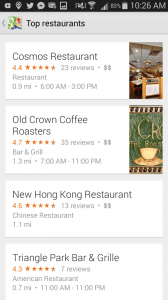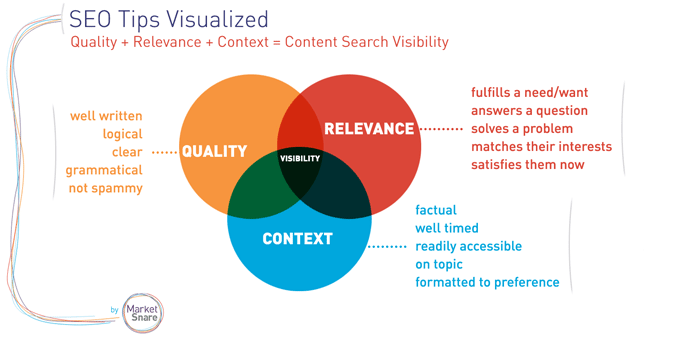The days of flippantly regurgitating Google’s “just write great content” mantra should be long behind us. Local visibility and search success require context and relevance in addition to quality. Quality alone is not enough, and to say it is grossly understates how search engines rank content, especially when a search query has geo-specific “market area” intent.
 Why is this the case? Well, in no small part because of the massive increase in search queries with local intent, the abundance of mobile devices capable of tying geo-local searches to a geo-specific location, and Google’s ability to tie the two together. Let’s not forget all the information we’ve shared via social channels and our signed-in search history, either, which makes understanding our intent and interests possible.
Why is this the case? Well, in no small part because of the massive increase in search queries with local intent, the abundance of mobile devices capable of tying geo-local searches to a geo-specific location, and Google’s ability to tie the two together. Let’s not forget all the information we’ve shared via social channels and our signed-in search history, either, which makes understanding our intent and interests possible.
In the case of the recently released (July 23)Google Explore button of Google Maps and the revised Foursquare App (August 6), “context” takes on the meaning of where you are, what time of day it is, and what you or your friends already like. “Local relevance” means returning results that are of the highest quality, meet the criteria of your query, and fit its context. This also is true for traditional local search methods, which are certainly cause for the recent (July 24) Google Local Pigeon update. More on that in a minute.
 How dare I insinuate that quality is a lessor signal? Actually, quality is always important. But in search it is weighed against context and relevance. This is why “Top restaurants”, a Google Explore feature, will show a 4.4-star lunch restaurant with 23 total reviews above a 4.7-star coffee shop with 35 reviews: the quality is offset by the fact that I only go to coffee shops for their wifi, and Google and Foursquare know it.
How dare I insinuate that quality is a lessor signal? Actually, quality is always important. But in search it is weighed against context and relevance. This is why “Top restaurants”, a Google Explore feature, will show a 4.4-star lunch restaurant with 23 total reviews above a 4.7-star coffee shop with 35 reviews: the quality is offset by the fact that I only go to coffee shops for their wifi, and Google and Foursquare know it.
Put simply, people will give up some level of quality for the sake of immediacy, proximity, budget, and, as depicted above, habit. We are, after all, creatures of habit and will often default to brands we know and trust, unless very strong signals are presented that lead us to a different choice. Those signals must give us enough confidence to accept unknowns. And they will still be based on what we need (lunch) and/or want (Chinese food). Alternate options must come with a low risk of disappointment, which online is oft conveyed by way of recommendations and reviews.
A common mistake, though, is that business owners, marketers, and even some SEO practitioners become far too fixated on any one search signal or tactic. Yes, reviews are very important, but so are exact-match citations. Are your IYP listings uniform and correct? Is your on-page NAP wrapped in schema? These are best-practice standards your web professional should be taking care of. Your job is to optimize past the mechanics by ensuring that local context, relevance, and, yes, quality are part of your site optimization mix.
Better proof of local context and relevance is also why some Google Local results – 3-pack, 7-pack, carousel, and maps – will show businesses with no reviews above those with excellent reviews and absolutely impact the standard organic results; that is to say, those that are not paid or part of the “local pack.” This is a point that dealer networks, franchises, and other local service providers should be very mindful of. It is hard to prove to Google that you really are important to a geographical area with two paragraphs on a manufacturer’s location listing page.
What are some examples of content you can use to build local context and local relevance?
-
Make references in copy to your local area, events, organizations, and your business’s participation in local activities.
-
Use local language, references, geographic landmarks, and waypoint mentions.
-
Run events, name them with local references, and talk about the communities you invite to participate.
-
Shoot pictures and videos of your events and business happenings with a camera that embeds geo-location data and post them on your site.
-
Add appropriate alt-text to images that describe local landmarks pictured.
-
Create individual staff bio pages that contain content and images referencing your staff’s involvement in the area.
-
Include local references in the About Us section of your website.
You can use our Content Opportunity Report to help organize these ideas and include them in your content marketing strategy.
Google continues to try to find new ways to ensure that local context, relevance, and quality are reflected in their results when local search intent is detected. Evidence of this is their recent Pigeon update, mentioned above, which brought signals from Google’s natural search algorithms into their local search results.
If your search result competition is moderate to heavy, you cannot simply prove you are in a geographical area, you must also present how you fit in and fill a need, and why you matter to that area. If you are a company with tens to thousands of individual dealers, franchises, or locations, contact us to see how we can help improve your local context, relevance, and visibility.

